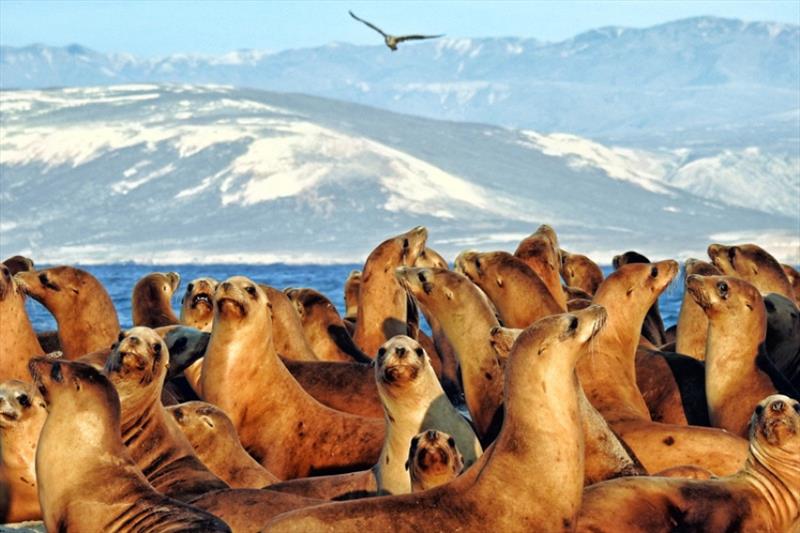
California sea lion population rebounded to new highs
by NOAA Fisheries 19 Jan 2018 15:58 UTC

Group of California sea lion adult females and juveniles observing NMFS/NMML biologists at San Miguel Island, California © NOAA Fisheries
California sea lions have fully rebounded under the protection of the Marine Mammal Protection Act (MMPA), with their population on the West Coast reaching carrying capacity in 2008 before unusually warm ocean conditions reduced their numbers, according to the first comprehensive population assessment of the species.
The sea lion population is healthy and robust, the new research found, and its recovery over the past several decades reflects an important success for the MMPA. The landmark 1972 legislation recognized marine mammals as a central element of their ocean ecosystems, setting population goals based on levels that would contribute to the health and stability of those ecosystems.
The MMPA calls those levels the Optimum Sustainable Population (OSP), and provides options for states to take over management of species that have reached their OSP.
California sea lions have now reached those levels, according to the new assessment by scientists from NOAA Fisheries' Alaska Fisheries Science Center and Southwest Fisheries Science Center. They published the results of the long-term collaborative study today in the Journal of Wildlife Management.
"The population has basically come into balance with its environment," said coauthor Sharon Melin, a research biologist at the Alaska Fisheries Science Center who has tracked sea lion numbers in Southern California's Channel Islands for years. "The marine environment is always changing, and their population is at a point where it responds very quickly to changes in the environment."
Scientists combined the results of sea lion pup counts in the Channel Islands, aerial surveys of sea lion rookeries, survival rates and other information to reconstruct the growth of the sea lion population from 1975 to 2014. They gained enough insight into the dynamics of the population to fill in gaps from a few years with little data.
Market hunting, bounties, pollutants such as DDT and other forces depressed sea lion numbers in the middle of the last century. The new study found that the species then rose from less than 90,000 animals in 1975 to an estimated 281,450 in 2008, which was roughly the carrying capacity for sea lions in the California Current Ecosystem at that time. It then fluctuated around that level, reaching a high of 306,220 in 2012 before declining below the carrying capacity in the years since as ocean conditions changed.
Such a long-term reconstruction of the sea lion population has never been done before, said Robert DeLong, leader of the Alaska Fisheries Science Center's California Current Ecosystems Program and a coauthor of the new research.
The researchers found sea lion numbers very sensitive to environmental changes, especially changes in ocean temperatures that affect their prey. Their models based on past population shifts predict that an increase of one degree C in sea surface temperature off the West Coast will reduce sea lion population growth to zero, while an increase of 2 degrees will lead to a seven percent decline in the population.
"When the California Current is not productive, they respond pretty fast and dramatically," Melin said. "They're out there in the ocean sampling it all the time. That makes them a very powerful indicator of what's happening in the marine environment."
Marine conditions since 2012 have illustrated that. An unusual marine heat wave off the West Coast known as "the blob" combined with an El Niño climate pattern reduced pup production and survival, with thousands of malnourished pups stranding on Southern California beaches. NOAA Fisheries declared the elevated number of deaths an Unusual Mortality Event in 2013.
The sea lion population dropped to just over 250,000 in 2013 and 2014.
"This is not just a story about continued growth of the population," DeLong said. "These last several years have brought new environmental stresses to the California Current, and we've seen that reflected by the sea lions."
Understanding the relationship between sea lion numbers and the environment can help scientists detect signals of coming change. Wildlife managers can then use that information to anticipate and prepare for shifts in the ecosystem and its inhabitants.
"It helps us to understand the factors driving this population, because we can incorporate them into management decisions," said Chris Yates, Assistant Regional Administrator for Protected Resources in NOAA Fisheries' West Coast Region.
The general recovery of sea lion numbers has had other consequences on the West Coast, including conflicts with people over beach access where sea lions haul out and concern about sea lion predation on threatened and endangered salmon and steelhead in the Northwest. NOAA Fisheries has authorized Oregon, Washington and Idaho to remove individually identifiable sea lions near the Columbia River's Bonneville Dam that have been spotted repeatedly preying on fish protected under the Endangered Species Act.
The species maintained OSP levels even when small numbers of adult males were being removed to protect salmon runs in the Columbia River and climate events were depressing growth. That suggests that the removal of a limited number of sea lions in such programs is unlikely to affect the population as a whole, Melin said.
She stressed the value of long-term data in understanding the dynamics of the population. "If we had looked only at the last five years, we would have thought sea lions were in a tailspin," she said. "Because we know the history of the population, we can put the recent decline in perspective."